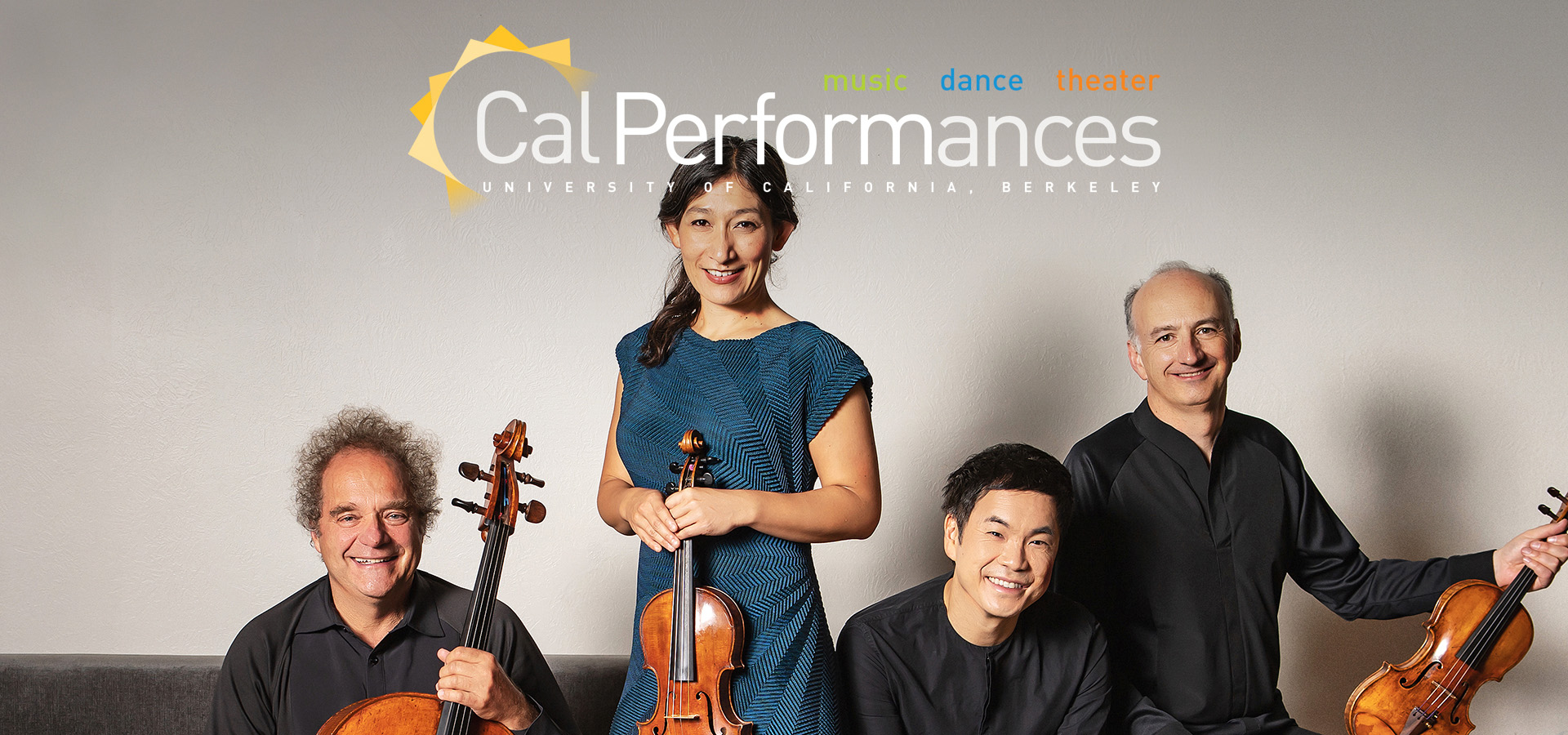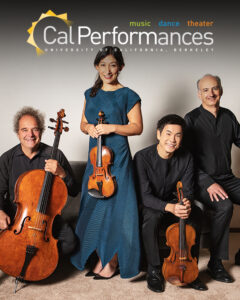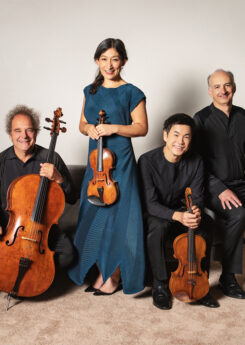The Takács Quartet
Sunday, February 25, 2024, 3pm
Hertz Hall
Edward Dusinberre, violin
Harumi Rhodes, violin
Richard O’Neill, viola
András Fejér, cello
This concert is dedicated in memory of Liz Lutz.
The Takács Quartet appears by arrangement with Seldy Cramer Artists, and records for Hyperion and Decca/London Records.
The Takács Quartet is Quartet-in-Residence at the University of Colorado in Boulder; the members are Associate Artists at Wigmore Hall, London.
www.takacsquartet.com
Cal Performances is committed to fostering a welcoming, inclusive, and safe environment for all—one that honors our venues as places of respite, openness, and respect. Please see the Community Agreements section on our Policies webpage for more information.
From the Executive and Artistic Director
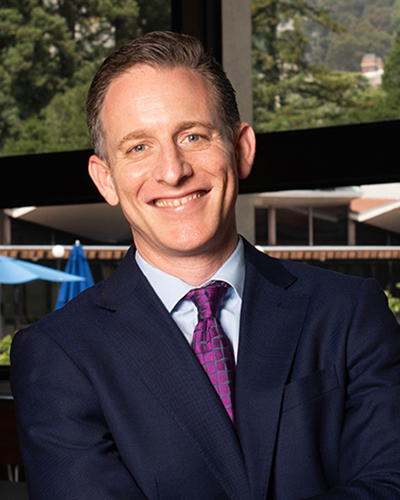
I’m so pleased to welcome you back to campus as we move into the second half of our extraordinary 2023–24 season. There are far too many highlights this month for me to mention each and every one, but I can’t help but single out a few standout events. Of course, any visit by the legendary soprano Renée Fleming is worthy of attention, and this month’s Zellerbach Hall appearance is no exception, coming, as it does, hot on the heels of her receiving the prestigious Kennedy Center Honor for lifetime artistic achievement in December. For dance, you won’t want to miss a dazzling double-bill pairing the late Pina Bausch’s iconic The Rite of Spring with common ground[s], a new duet co-created and performed by septuagenarians Germaine Acogny, known as the “mother of African contemporary dance,” and Malou Airaudo, a longtime dancer with the Tanztheater Wuppertal Pina Bausch. Featuring more than 30 dancers from 14 African countries assembled through a collaboration with Germany’s Pina Bausch Foundation, Senegal’s École des Sables, and the UK’s Sadler’s Wells theater, this program is the type of large-scale and ambitious artistic collaboration that has long defined Cal Performances. And finally, we’re tremendously excited about Taylor Mac & Matt Ray’s upcoming Bark of Millions (see page 6 for more details), an epic “parade trance extravaganza” that celebrates queerness in all its facets and the power of individuality and human connection to push boundaries and bring bold and fresh perspectives to our stage.
As spring approaches, we will continue to invest in ongoing relationships with established and acclaimed artistic partners, with upcoming projects including the renewal of a multi-season residency by The Joffrey Ballet, which this year will present its first full-length narrative ballet, Anna Karenina, at Zellerbach Hall. And I’m especially pleased that in March, the renowned pianist Mitsuko Uchida will join us as Artist in Residence for two special concerts as well as additional opportunities for the campus and wider Bay Area community to engage with her singular artistry.
An ongoing focus of the season is our multi-dimensional Illuminations programming, which once again connects the work of world-class artists to the intellectual life and scholarship at UC Berkeley via performances and public programs investigating a pressing theme—this season, “Individual & Community.” Concepts of “individual” and “community” have been at the forefront of public discourse in recent years, with new questions emerging as to how we can best nurture a sense of community and how the groups we associate with impact our own sense of self. Given our fast-evolving social landscape, how can we retain and celebrate the traits that make each of us unique, while still thriving in a world that demands cooperation and collaboration? With the performing arts serving as our guide and compass, we will explore the tensions that come into play when balancing the interests of the individual with those of the group.
Finally, I want to mention a major new venture coming up next season, the Maria Manetti Shrem and Elizabeth Segerstrom California Orchestra Residency, when Cal Performances and the Philharmonic Society of Orange County will bring the world renowned Vienna Philharmonic and conductor Yannick Nézet-Séguin to California during spring 2025. Made possible by philanthropists Maria Manetti Shrem and Elizabeth Segerstrom, three performances at Zellerbach Hall (March 5–7) will be followed by two in Orange County (March 9 and 11) at the Renée and Henry Segerstrom Concert Hall. Programs will feature works by Mozart, Schubert, Dvořák, Mahler, and Richard Strauss, with acclaimed pianist Yefim Bronfman set to join the orchestra for a Beethoven concerto appearance. Exact programming will be announced shortly, and on-sale dates will be provided in April, when Cal Performances’ 2024–25 season is announced to the general public.
Again, welcome to Cal Performances! We’re delighted to join together, celebrating the very best in live music, dance, and theater.
Jeremy Geffen
Executive and Artistic Director, Cal Performances
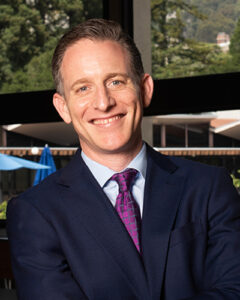 I’m so pleased to welcome you back to campus as we move into the second half of our extraordinary 2023–24 season. There are far too many highlights this month for me to mention each and every one, but I can’t help but single out a few standout events. Of course, any visit by the legendary soprano Renée Fleming is worthy of attention, and this month’s Zellerbach Hall appearance is no exception, coming, as it does, hot on the heels of her receiving the prestigious Kennedy Center Honor for lifetime artistic achievement in December. For dance, you won’t want to miss a dazzling double-bill pairing the late Pina Bausch’s iconic The Rite of Spring with common ground[s], a new duet co-created and performed by septuagenarians Germaine Acogny, known as the “mother of African contemporary dance,” and Malou Airaudo, a longtime dancer with the Tanztheater Wuppertal Pina Bausch. Featuring more than 30 dancers from 14 African countries assembled through a collaboration with Germany’s Pina Bausch Foundation, Senegal’s École des Sables, and the UK’s Sadler’s Wells theater, this program is the type of large-scale and ambitious artistic collaboration that has long defined Cal Performances. And finally, we’re tremendously excited about Taylor Mac & Matt Ray’s upcoming Bark of Millions (see page 6 for more details), an epic “parade trance extravaganza” that celebrates queerness in all its facets and the power of individuality and human connection to push boundaries and bring bold and fresh perspectives to our stage.
I’m so pleased to welcome you back to campus as we move into the second half of our extraordinary 2023–24 season. There are far too many highlights this month for me to mention each and every one, but I can’t help but single out a few standout events. Of course, any visit by the legendary soprano Renée Fleming is worthy of attention, and this month’s Zellerbach Hall appearance is no exception, coming, as it does, hot on the heels of her receiving the prestigious Kennedy Center Honor for lifetime artistic achievement in December. For dance, you won’t want to miss a dazzling double-bill pairing the late Pina Bausch’s iconic The Rite of Spring with common ground[s], a new duet co-created and performed by septuagenarians Germaine Acogny, known as the “mother of African contemporary dance,” and Malou Airaudo, a longtime dancer with the Tanztheater Wuppertal Pina Bausch. Featuring more than 30 dancers from 14 African countries assembled through a collaboration with Germany’s Pina Bausch Foundation, Senegal’s École des Sables, and the UK’s Sadler’s Wells theater, this program is the type of large-scale and ambitious artistic collaboration that has long defined Cal Performances. And finally, we’re tremendously excited about Taylor Mac & Matt Ray’s upcoming Bark of Millions (see page 6 for more details), an epic “parade trance extravaganza” that celebrates queerness in all its facets and the power of individuality and human connection to push boundaries and bring bold and fresh perspectives to our stage.
As spring approaches, we will continue to invest in ongoing relationships with established and acclaimed artistic partners, with upcoming projects including the renewal of a multi-season residency by The Joffrey Ballet, which this year will present its first full-length narrative ballet, Anna Karenina, at Zellerbach Hall. And I’m especially pleased that in March, the renowned pianist Mitsuko Uchida will join us as Artist in Residence for two special concerts as well as additional opportunities for the campus and wider Bay Area community to engage with her singular artistry.
An ongoing focus of the season is our multi-dimensional Illuminations programming, which once again connects the work of world-class artists to the intellectual life and scholarship at UC Berkeley via performances and public programs investigating a pressing theme—this season, “Individual & Community.” Concepts of “individual” and “community” have been at the forefront of public discourse in recent years, with new questions emerging as to how we can best nurture a sense of community and how the groups we associate with impact our own sense of self. Given our fast-evolving social landscape, how can we retain and celebrate the traits that make each of us unique, while still thriving in a world that demands cooperation and collaboration? With the performing arts serving as our guide and compass, we will explore the tensions that come into play when balancing the interests of the individual with those of the group.
Finally, I want to mention a major new venture coming up next season, the Maria Manetti Shrem and Elizabeth Segerstrom California Orchestra Residency, when Cal Performances and the Philharmonic Society of Orange County will bring the world renowned Vienna Philharmonic and conductor Yannick Nézet-Séguin to California during spring 2025. Made possible by philanthropists Maria Manetti Shrem and Elizabeth Segerstrom, three performances at Zellerbach Hall (March 5–7) will be followed by two in Orange County (March 9 and 11) at the Renée and Henry Segerstrom Concert Hall. Programs will feature works by Mozart, Schubert, Dvořák, Mahler, and Richard Strauss, with acclaimed pianist Yefim Bronfman set to join the orchestra for a Beethoven concerto appearance. Exact programming will be announced shortly, and on-sale dates will be provided in April, when Cal Performances’ 2024–25 season is announced to the general public.
Again, welcome to Cal Performances! We’re delighted to join together, celebrating the very best in live music, dance, and theater.
Jeremy Geffen
Executive and Artistic Director, Cal Performances
About the Program
Hugo Wolf
Italian Serenade
Listening to music as upbeat as Hugo Wolf’s Italian Serenade, seven effervescent minutes, you cannot imagine it composed by a man who struggled with debilitating depression, the maladies of self-pity, and the ravages of syphilis, all ailments that fueled his bad temper. Wolf made his mark not just as a composer but also as a critic, where his irascibility erupted in scathing reviews repaid by their targets with equally scathing assessments of his music. German composers in the later 19th century fell into two camps, and the mutual contempt between conservatives and progressives stopped just short of what we endure in today’s US politics. Wolf’s devotion to the pathbreaking Wagner stoked his hatred of the classicist Brahms, whom he once called a master of “composing without ideas.” As proof, he offered the great Fourth Symphony. There, Wolf wrote, Brahms outdid himself in “nothingness, emptiness and hypocrisy.”
Insults like that won no friends among Viennese critics who adored Brahms, and Wolf paid the price. Yet after he turned from criticism to full-time composing, the quality of his music prevailed, no doubt helped by what is said to have been his personal charm. Apparently, his temperament resembled a panorama of lovely peaks and dismal valleys. His bipolar ordeal, along with syphilitic dementia, drove Wolf in 1899 to attempt suicide. After that, he asked to be committed to a sanatorium. He lived only four more years. He is remembered today mainly for his songs, which enjoy a place in the lieder tradition of Schubert, Schumann, and Wolf’s nemesis, Brahms. They are that good.
Wolf composed the Italian Serenade in two days, in May 1887, shortly after giving up his work as a music critic. In 1892, he orchestrated the serenade for chamber ensemble. He intended to expand the quartet version to three movements and the orchestral version to four, but he carried out neither plan. The serenade suggests nothing of its creator’s trials or anxieties. Such leaping, swinging music—you could almost believe it is folk music—might be encountered in the Tuscan hills. Imagine it in the background at a long al fresco table set with overflowing platters and full decanters and laughing companions.
Béla Bartók
String Quartet No. 2 in A minor
When he completed his First String Quartet in 1908, Bartók had recently discovered the music of Debussy, and since 1905 he had immersed himself in what became another source of inspiration: peasant music. Armed with wax cylinders and a recorder, he visited villages in his native Hungary, urging (often with the encouragement of a pint) the men and women there to sing the old tunes passed down to them but never notated. Soon he expanded his research to other lands, including Romania, Turkey, and North Africa. Peasant tunes helped shape Bartók’s mature style, yet they rarely made their way into his work literally. As Peter Laki points out, “Bartók did not quote any actual folk songs in his quartets; instead, he isolated certain structural elements from these folksongs, such as a melodic turn, a rhythmic pattern, or a typical scale.”
Perhaps it was through Debussy that Bartók assimilated a sense of ebb and flow, structural fluidity. Along with that, he filled his stylistic arsenal with the thousand musical tricks that farmers and wheelwrights and washer-women demonstrated for him in taverns and fields. All this seems unlikely preparation for the body of work that would follow, which includes six string quartets that at least one writer, Halsey Stevens, believes “worthy of being placed beside those of the Viennese masters.”
Bartók wrote his Second String Quartet between 1914 and 1917, and its pages seem saturated with the gloom of the First World War. Analysis seems to miss the point of this gut-punching music. Bartók’s friend and fellow composer Zoltán Kodály could not resist attaching a sketchy program to it, though to characterize its three movements (as he did) as representing “1. A quiet life. 2. Joy. 3. Sorrow” illustrates the shortcomings of programs. Yet if this music were a film score, its angles and sharp edges might evoke the Great War—not its battles so much as the spiritual wounds those battles left.
The tortured, lamenting first movement seems touched by the heated late-Romantic spirit we find in a work such as Schoenberg’s Transfigured Night. The second-movement Allegro is a wild peasant dance, agitated, intense, and obsessive, spelled by a slower middle section in which the players meditate upon a keening passage. The lamenting Lento finale might remind us that, when the quartet was premiered, seven months of the war were still left. The violins begin the dirge. A little more than halfway through the movement’s 10-odd minutes, a figure for high voices moves upward in thirds and is answered by the lower voices, recalling music Bernard Herrmann composed for Alfred Hitchcock’s Vertigo. From this the music gathers momentum, draws back, searches for an exit, finds it in the last dying lines and the plucked final notes.
Franz Schubert
String Quartet No. 15 in G major, D. 887
Like so many composers, Schubert aspired to write symphonies like Beethoven’s, and, like so many composers, he fell short. Yes, he wrote an elegant Fifth Symphony, a profound Unfinished, an architecturally massive Great C major. Many Schubert lovers, however, will tell you to seek the composer first of all in his chamber music. He discovered his genius not in emulating Beethoven but in being himself. That genius is intimate. It is subtle. It asks us for our time.
Take, for example, the Schubert we hear this afternoon. This is his last string quartet, written in 1826 (in 10 days) and first played at a private performance in 1827, the year before the composer died. Late Schubert, though not modeled on late Beethoven, is likewise filled with distinctive oddities such as most contemporary audiences had not encountered, and it relies on listeners to set aside preconceptions and engage actively with the music. This is the same Schubert whose many songs, whether cheerful or melancholy, were gifts that needed no unwrapping, for they appealed openly and directly to those who heard them. In songs, of course, the music conveys the meaning of the texts, but the reverse is also true, the texts help us enjoy the music, help us believe we have grasped the composer’s intent. In Schubert’s chamber music, the absence of textual aids leaves us confronting an abstract span of sound. In making sense of such works—taking them to our hearts, making them ours, getting them—we’re on our own. And while all music lacking text or program presents a listener with a similar challenge, the contrast in Schubert is especially striking—the vividly concrete songs on the one hand, the elusive late chamber music and sonatas on the other. Schubert is hardly the only composer to produce some music that appeals to a wide audience and other music that appeals to connoisseurs, but the two aspects of Schubert’s artistry seem to have created a conflict that undid him. While he could count on listeners for his salon pieces, he believed immortality lay in more ambitious productions, but publishers remained unwilling to back his aspirations with their resources. Perhaps he simply needed better luck, better contacts, better PR skills. Imagine his reaction to a letter from the publisher Probst, rejecting a set of late works he had hoped to sell. “The public does not yet sufficiently and generally understand the peculiar, often ingenious, but perhaps now and then somewhat curious procedures of your mind’s creations.” This translates to Don’t quit your day job, useless advice for a man whose day job was composing.
The G major quartet begins with a long inhalation, a major triad that immediately leaps upward and into minor, dynamics simultaneously building to fortissimo. The gesture creates enormous tension. Schubert biographer Brian Newbould identifies it as the work’s first “theme,” and in various guises you will hear it again and again. The breath just taken in is expelled: a staccato outburst of six short notes, the last two echoed softly before the brief opening gesture is repeated. Without warning, Schubert now asks us to focus on something different, an extended tremolo passage, pianissimo, above which the first violin introduces a theme derived from the staccato outburst, only now it is serene, and in the major mode rather than minor. The cello responds to this, and then all join in full-throated song, radiant, even ecstatic. The music feels big. It all but begs for orchestration.
Now listen even more closely, for nothing that follows in this long movement is obvious. The radiant song segues into the movement’s second theme. Is it stalking or innocent? Melancholy or optimistic? Without answering those questions, the music grows impassioned. As it subsides, the cellist explores the second theme from a pensive point of view; but, as though impatient with such brooding, the others intervene with a more aggressive version of the same music, then retreat to allow the viola his upbeat take on the theme. The tremolos return, but what was subdued earlier is now forceful. Then, led by first violin and viola, comes a riff on the radiant song heard minutes earlier. Tremulous, tortured passages ensue, spelled by moments of otherworldly calm. The recapitulation is no literal repeat of music we have heard earlier. In a stroke more readily described than discerned, the opening gesture is now reversed, a minor chord here giving way to major, and the tension of the opening dissipates briefly. With the ever-present tremolos and a recollection of the quartet’s first moments, the movement ends.
The mournful song that opens the Andante sounds like a country dance played at half speed, as though this is a recollection of happier times. An impassioned outburst, and then tremolos intrude, seeming to come from nowhere. The sad dance is reprised and explored. Heard over tremolos, it yearns to be optimistic and rises into major, residing there tentatively, until a short coda ends the movement.
The scherzo trembles, agitated and anxious until the central section, which the cello introduces with a long held note. The others join in a song, sweet and melancholy—again, to call this ecstatic is no overstatement. It is cut short with the return of the nervous music of the movement’s first section.
Opening abruptly, the finale unfolds in stabbing rhythms and nervous song, an obsessive perpetual motion that now and again attempts to relax but cannot. Were it not for the full stop proclaimed by the final unison gesture, we could imagine the music continuing to careen toward the catastrophe that has haunted this unsettling quartet from its first moments.
—Larry Rothe
Larry Rothe writes about music for Cal Performances and San Francisco Opera. Visit larryrothe.com.


